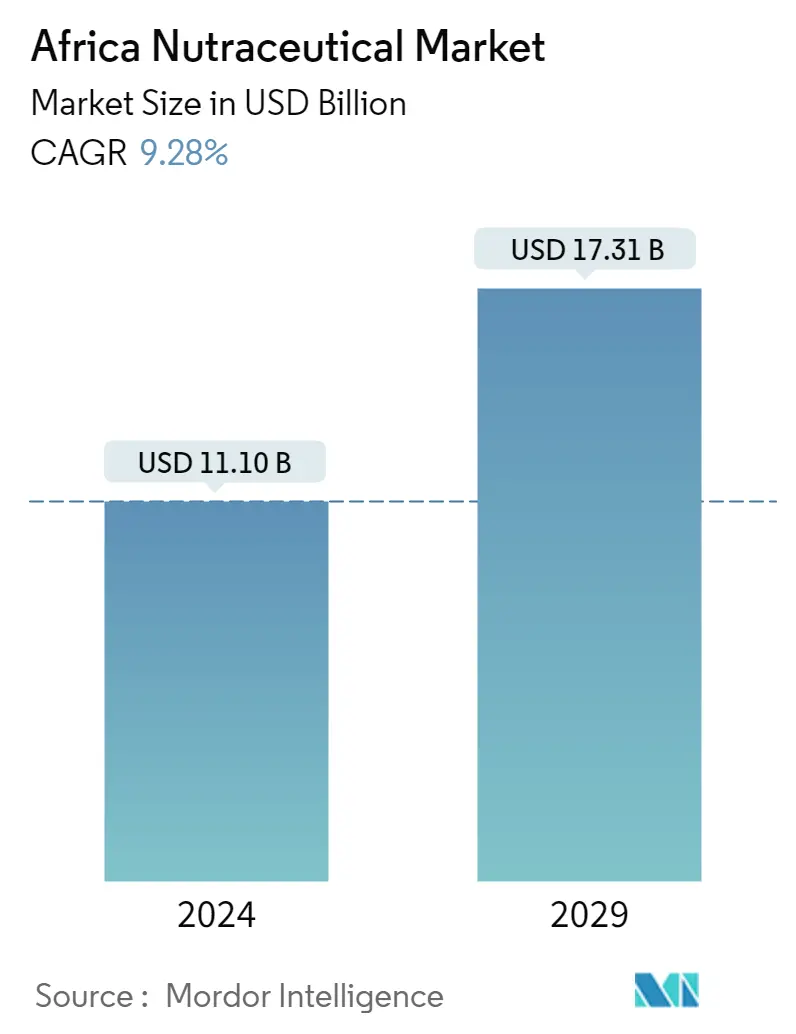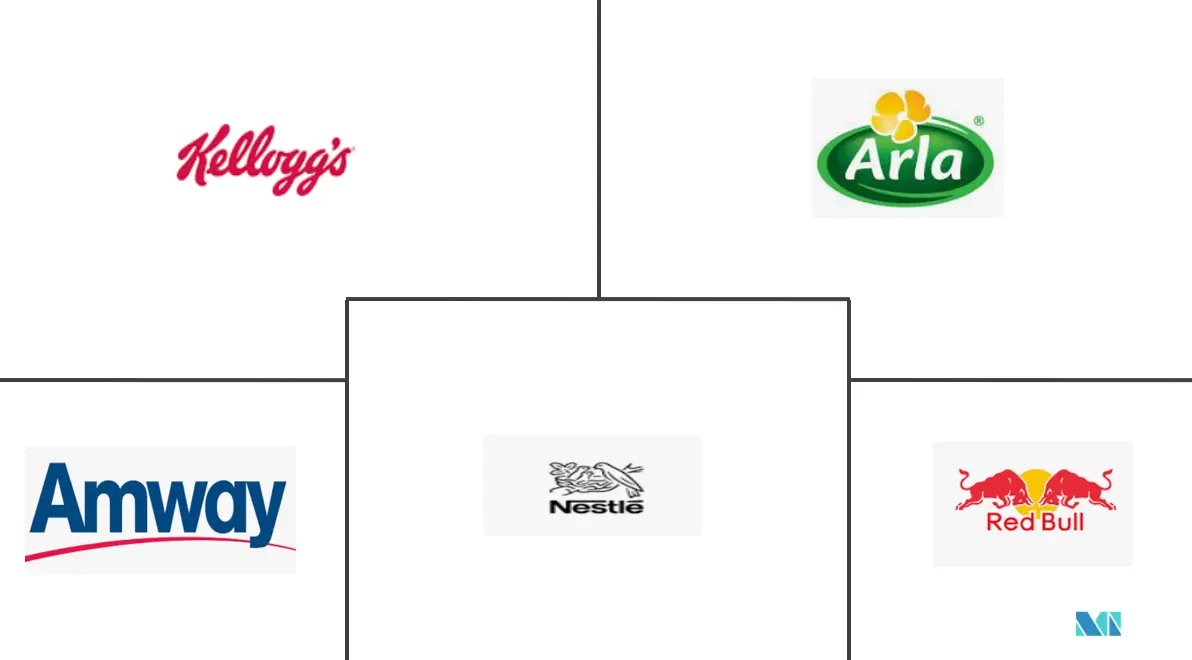Market Size of Africa Nutraceutical Industry

| Study Period | 2019 - 2029 |
| Base Year For Estimation | 2023 |
| Market Size (2024) | USD 11.10 Billion |
| Market Size (2029) | USD 17.31 Billion |
| CAGR (2024 - 2029) | 9.28 % |
| Market Concentration | Low |
Major Players
*Disclaimer: Major Players sorted in no particular order |
Africa Neutraceutical Market Analysis
The Africa Nutraceutical Market size is estimated at USD 11.10 billion in 2024, and is expected to reach USD 17.31 billion by 2029, growing at a CAGR of 9.28% during the forecast period (2024-2029).
International health organizations, such as WHO, are encouraging consumers to strengthen their immune systems to prevent COVID-19. Various nutraceuticals are more popular for their immunity-boosting properties. Since vitamin C, zinc, and vitamin E are popular ingredients known for enhancing immunity, leading manufacturers are increasingly incorporating them into food, beverages, and supplements to tap into the market. The health trend has recently gained more momentum, giving rise to the entry of global players into the market. For instance, in 2020, Royal DSM, a leading science company in nutrition, the United Nations children's rights agency, United Nations Children's Fund (UNICEF), and Swiss-based nutrition think tank, Sight and Life, announced the extension of their cross-sector partnership, focusing on delivering better nutrition to at-risk children and mothers in South Africa until the end of 2021. The COVID-19 crisis is likely to accelerate trends that were already shaping the market, such as the rise of the middle class and the use of e-commerce.
The infant nutrition industry's growth and the demand for healthy and nutritious food and beverages are driving the nutraceutical market in Africa. Market accessibility and low economic conditions in the region restrain this market. Moreover, Egypt and South Africa are trying to adopt more plant-based nutraceuticals, which is a great opportunity in the African market.
The increasing incidence of non-communicable diseases and rising medical expenses, and an obligation to fortify foods by government agencies in the region, have been pushing the demand for nutraceuticals. Lifestyle changes and increased consumption of packaged foods are the major reasons for the increased prevalence of lifestyle-related diseases, such as cardiovascular diseases and diabetics, which is further boosting the demand for alternative healthy foods like functional foods in the region.
Africa Neutraceutical Industry Segmentation
Nutraceutical products have physiological benefits, protect against chronic diseases, improve health, delay the aging process, and increase life expectancy. The African nutraceutical market is segmented by product type, distribution channel, and geography. The market sizing and forecast have been done for each segment based on the value (in USD million).
| By Type | |||||||||
| |||||||||
| |||||||||
|
| By Distribution Channel | |
| Supermarkets/Hypermarkets | |
| Convenience Stores | |
| Drug/Pharamacies | |
| Online Retail Stores | |
| Other Distribution Channels |
| By Geography | |
| South Africa | |
| Nigeria | |
| Egypt | |
| Rest of Africa |
Africa Nutraceutical Market Size Summary
The African nutraceutical industry is experiencing significant growth, driven by increasing health awareness and a shift towards preventive healthcare. The market is expanding as consumers become more conscious of their health, leading to a higher demand for products that offer immunity-boosting and health-enhancing benefits. This trend is further fueled by the rising prevalence of non-communicable diseases and lifestyle-related health issues, such as obesity and diabetes, which are prompting a shift towards functional foods and nutraceuticals. The entry of global players and the adoption of e-commerce are also contributing to the market's expansion, as companies seek to capitalize on the growing middle class and their changing dietary preferences.
In South Africa, the nutraceutical market is particularly influenced by changing consumer lifestyles and the increasing popularity of fitness and wellness trends. The demand for natural sweeteners and plant-based nutraceuticals is on the rise, reflecting a broader shift towards healthier food choices. Key multinational companies, such as Arla Foods, Nestle, and The Kellogg Company, dominate the market, leveraging strategies like product innovation and strategic partnerships to maintain their competitive edge. Despite challenges such as economic constraints and limited local ingredient suppliers, the market is poised for continued growth, supported by ongoing consumer interest in health and wellness.
Africa Nutraceutical Market Size - Table of Contents
-
1. MARKET DYNAMICS
-
1.1 Market Drivers
-
1.2 Market Restraints
-
1.3 Porter's Five Forces Analysis
-
1.3.1 Threat of New Entrants
-
1.3.2 Bargaining Power of Buyers/Consumers
-
1.3.3 Bargaining Power of Suppliers
-
1.3.4 Threat of Substitute Products
-
1.3.5 Intensity of Competitive Rivalry
-
-
-
2. MARKET SEGMENTATION
-
2.1 By Type
-
2.1.1 Functional Food
-
2.1.1.1 Cereal
-
2.1.1.2 Bakery
-
2.1.1.3 Confectionery
-
2.1.1.4 Dairy
-
2.1.1.5 Snacks
-
-
2.1.2 Functional Beverages
-
2.1.2.1 Energy Drinks
-
2.1.2.2 Sports Drinks
-
2.1.2.3 Fortified Food
-
2.1.2.4 Dairy and Dairy Alternative Beverages
-
-
2.1.3 Dietary Supplements
-
2.1.3.1 Vitamins
-
2.1.3.2 Minerals
-
2.1.3.3 Botanicals
-
2.1.3.4 Enzymes
-
2.1.3.5 Fatty Acids
-
2.1.3.6 Proteins
-
2.1.3.7 Other Dietary Supplements
-
-
-
2.2 By Distribution Channel
-
2.2.1 Supermarkets/Hypermarkets
-
2.2.2 Convenience Stores
-
2.2.3 Drug/Pharamacies
-
2.2.4 Online Retail Stores
-
2.2.5 Other Distribution Channels
-
-
2.3 By Geography
-
2.3.1 South Africa
-
2.3.2 Nigeria
-
2.3.3 Egypt
-
2.3.4 Rest of Africa
-
-
Africa Nutraceutical Market Size FAQs
How big is the Africa Nutraceutical Market?
The Africa Nutraceutical Market size is expected to reach USD 11.10 billion in 2024 and grow at a CAGR of 9.28% to reach USD 17.31 billion by 2029.
What is the current Africa Nutraceutical Market size?
In 2024, the Africa Nutraceutical Market size is expected to reach USD 11.10 billion.

